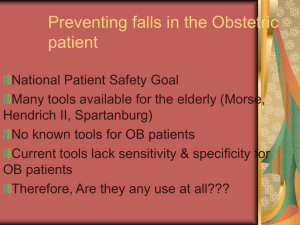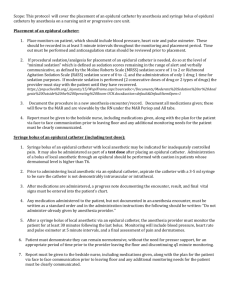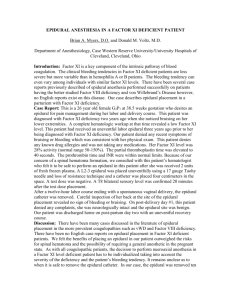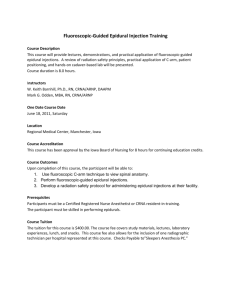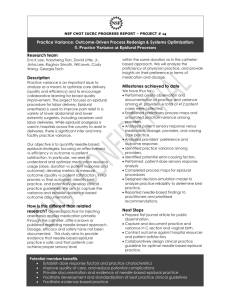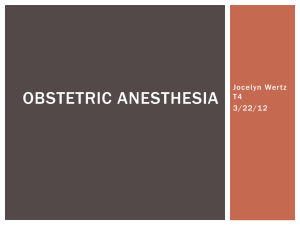PDF - Indigo Orb, Inc.
advertisement
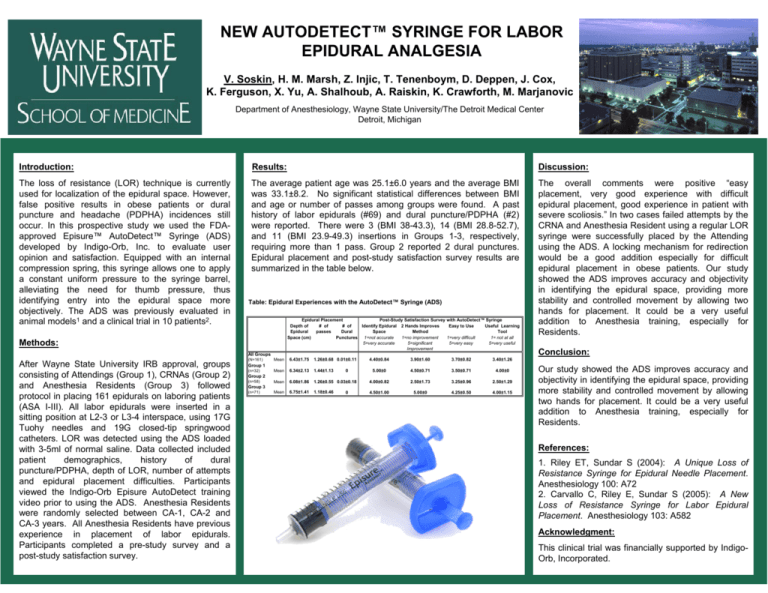
NEW AUTODETECT™ SYRINGE FOR LABOR EPIDURAL ANALGESIA V. Soskin, H. M. Marsh, Z. Injic, T. Tenenboym, D. Deppen, J. Cox, K. Ferguson, X. Yu, A. Shalhoub, A. Raiskin, K. Crawforth, M. Marjanovic Department of Anesthesiology, Wayne State University/The Detroit Medical Center Detroit, Michigan Introduction: Results: Discussion: The loss of resistance (LOR) technique is currently used for localization of the epidural space. However, false positive results in obese patients or dural puncture and headache (PDPHA) incidences still occur. In this prospective study we used the FDAapproved Episure™ AutoDetect™ Syringe (ADS) developed by Indigo-Orb, Inc. to evaluate user opinion and satisfaction. Equipped with an internal compression spring, this syringe allows one to apply a constant uniform pressure to the syringe barrel, alleviating the need for thumb pressure, thus identifying entry into the epidural space more objectively. The ADS was previously evaluated in animal models1 and a clinical trial in 10 patients2. The average patient age was 25.1±6.0 years and the average BMI was 33.1±8.2. No significant statistical differences between BMI and age or number of passes among groups were found. A past history of labor epidurals (#69) and dural puncture/PDPHA (#2) were reported. There were 3 (BMI 38-43.3), 14 (BMI 28.8-52.7), and 11 (BMI 23.9-49.3) insertions in Groups 1-3, respectively, requiring more than 1 pass. Group 2 reported 2 dural punctures. Epidural placement and post-study satisfaction survey results are summarized in the table below. The overall comments were positive “easy placement, very good experience with difficult epidural placement, good experience in patient with severe scoliosis.” In two cases failed attempts by the CRNA and Anesthesia Resident using a regular LOR syringe were successfully placed by the Attending using the ADS. A locking mechanism for redirection would be a good addition especially for difficult epidural placement in obese patients. Our study showed the ADS improves accuracy and objectivity in identifying the epidural space, providing more stability and controlled movement by allowing two hands for placement. It could be a very useful addition to Anesthesia training, especially for Residents. Table: Epidural Experiences with the AutoDetect™ Syringe (ADS) Epidural Placement Post-Study Satisfaction Survey with AutoDetect™ Syringe Identify Epidural 2 Hands Improves Easy to Use Useful Learning Depth of # of # of Space Method Tool Epidural passes Dural Space (cm) Punctures 1=not accurate 1=very difficult 1= not at all 1=no improvement 5=very easy 5=very useful 5=very accurate 5=significant Improvement Methods: All Groups After Wayne State University IRB approval, groups consisting of Attendings (Group 1), CRNAs (Group 2) and Anesthesia Residents (Group 3) followed protocol in placing 161 epidurals on laboring patients (ASA I-III). All labor epidurals were inserted in a sitting position at L2-3 or L3-4 interspace, using 17G Tuohy needles and 19G closed-tip springwood catheters. LOR was detected using the ADS loaded with 3-5ml of normal saline. Data collected included patient demographics, history of dural puncture/PDPHA, depth of LOR, number of attempts and epidural placement difficulties. Participants viewed the Indigo-Orb Episure AutoDetect training video prior to using the ADS. Anesthesia Residents were randomly selected between CA-1, CA-2 and CA-3 years. All Anesthesia Residents have previous experience in placement of labor epidurals. Participants completed a pre-study survey and a post-study satisfaction survey. (N=161) Mean 6.43±1.75 1.26±0.68 0.01±0.11 4.40±0.84 3.90±1.60 3.70±0.82 (n=32) Mean 6.34±2.13 1.44±1.13 5.00±0 4.50±0.71 3.50±0.71 4.00±0 Mean 6.08±1.86 1.26±0.55 0.03±0.18 4.00±0.82 2.50±1.73 3.25±0.96 2.50±1.29 Mean 6.75±1.41 1.18±0.46 4.50±1.00 5.00±0 4.25±0.50 4.00±1.15 0 Group 2 (n=58) Group 3 (n=71) 0 Conclusion: 3.40±1.26 Group 1 Our study showed the ADS improves accuracy and objectivity in identifying the epidural space, providing more stability and controlled movement by allowing two hands for placement. It could be a very useful addition to Anesthesia training, especially for Residents. References: 1. Riley ET, Sundar S (2004): A Unique Loss of Resistance Syringe for Epidural Needle Placement. Anesthesiology 100: A72 2. Carvallo C, Riley E, Sundar S (2005): A New Loss of Resistance Syringe for Labor Epidural Placement. Anesthesiology 103: A582 Acknowledgment: This clinical trial was financially supported by IndigoOrb, Incorporated.
